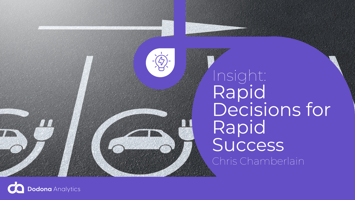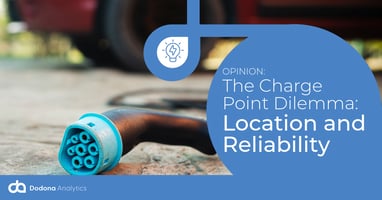The time is now. With a perfect storm of government regulation, investment, and rising electric...
Insights from the Frontlines of Electrification - The LCV rEVolution is coming!
-min.png)
Fleet & Mobility Live 2025 in Birmingham was a rare kind of event. It didn’t feel like the usual polished conference where the narrative is always upbeat and smooth. Instead, it was a reality check for anyone involved in the EV transition, especially those working on the complex challenge of fleet electrification.
This show was mostly focused on the Passenger and Light Commercial Vehicle (LCV) side of the Fleet rather than the Heavy Goods Vehicles (HGV) or Class 8 Trucks. My current thinking is that this is the "low-hanging fruit" not only for Fleet but probably for Electric Vehicle adoption in general.
Let me explain why. Firstly, many of the executive vehicles have been EVs for a while now and have become EV converts. Those are the Managers and Directors now, the ones making the decisions for vans, when those vehicle leases are up for renewal.
Secondly, the variety of vehicles available has improved, the range is extending, and the price is (slowly) reducing. Especially, the tariffs on Chinese vehicles are lower, and the production lines are producing more vehicles.
With the above in mind, I asked the Dodona Analytics Data Team to do a little research around what this may mean for EV adoption for the next 5 years, for both Passenger Cars and LCVs.
.png?width=1900&height=1200&name=Forecasted%202030%20Electric%20Vehicle%20Market%20Share%20by%20Region%20Passenger%20Cars%20vs.%20Light%20Commercial%20Vehicles%20(1).png)
It is pretty clear from the research above that whilst penetration of EVs across both sectors will be broadly similar by 2030, the percentage growth in EV LCVs will be significantly more: 2.5X in China and up 10X in the USA.
Whilst LCVs only make up 10-12% of the "smaller" vehicles on the road, they typically travel up to two times the mileage, therefore needing more charging events.
But the vehicles will charge in the Depots overnight, I hear you say! In many cases, they will, but the operational range will be affected by payload, refrigeration, and weather, etc... However, many of these vehicles will be "returning to home" or unable to charge at the Depot, or will need to charge intraday basis. This public charging will need to be efficient to maintain the operational efficiency of these fleets.
Therefore, we believe that the Public EV Charging infrastructure network that today has mostly been designed to serve passenger vehicles will need to take into account the public charging needs of LCVs as an important "demand layer". Public AC charging on the street and DC charging when speed is of the essence.
As data scientists this is a challenge that we have grappling with in recent months and our customers like FOR EV are taking this into account. You can see the Case Study for this here and if you would like to discuss this challenge with us, drop me a DM and we can get some time in the calendar.
Back to the show, over two days of sessions, three panels particularly stood out to me. They were candid, pragmatic discussions that highlighted what’s truly working, what’s still to be figured out, and where the next hurdles lie.
Change Management: The Real Pace Setter in Electrification
One of the most enlightening sessions came from Richard Guy , Fleet & Plant Director at Amey, along with Jonny Berry⚡️ Head of Net Zero Transition at Novuna Vehicle Solutions. They showcased a robust story of conversion, from a fleet of zero EVs to 50% electrified within just two years. But, it wasn’t technology that sold the story. It was people, process, and data; applied with care.
Richard emphasized how crucial it was to gain buy-in at the ground level, from drivers to operations, and to openly listen as issues arose. Early challenges weren’t batteries or performance curves but navigating logistical barriers like mileage reimbursement rates for home chargers and educating the workforce. Jonny brought it home with this simple, yet powerful mantra: “Trial things, see what works, then scale up what’s proven.”
Their approach underlined two truths: electrification is a transformation, not just a procurement exercise; and real-world data, reflecting true operational usage, must be the foundation. The lesson? Without engaging the community and reflecting on what’s actually happening on the ground, fleets risk stalled transitions or ill-fit solutions.
Commercial Fleets: The Next Frontier with Bigger Challenges
The commercial segment took center stage in a panel featuring Chris Connors, Lucy Stuart, Martin Edgecox MAFP. MARRM. IA Cert., and Andrew Teer, who together unpacked the tougher realities for electrifying vehicles beyond passenger cars.
Lucy painted a vivid picture: while 70% of car fleets are on the electric bandwagon, vans and specialist commercial vehicles face a distinct set of operational pressures. Running a 24/7 operation with vehicles towing heavy loads means battery range becomes a real constraint. Winter months exacerbate this, with typical ranges dropping from about 150 miles to closer to 120 miles, forcing fleets to rethink how they keep essential services running without interruption.
Chris pointed out the evolving nature of the market. There are still gaps in understanding and knowledge, both from fleet managers and drivers, which means education and openness to trial and error are critical going forward. Success here isn’t about flawless first moves but iterative learning and a strong partnership between OEMs, operators, and service providers.
The conversation returned time and again to operational planning and vehicle suitability, emphasizing that a ‘one size fits all’ approach won’t work. Understanding duty cycles, tailoring solutions, and embedding flexibility into operations will define the coming years.
Infrastructure: The Quiet Constraint That Couldn’t Be Ignored
The third panel I attended featured infrastructure heavyweights Stuart Murphy from Royal Mail, Neil Madgwick of UK Power Networks, and Matt Pretorius MAFP of Octopus Electroverse. Their discussion shifted focus from vehicles to what’s often called the “invisible bottleneck”: charging infrastructure.
Even with the latest EV models available, depots and grid connections frequently become the pinch points in scaling electrification. The panelists shared real stories of long lead times with Distribution Network Operators (DNOs), planning delays, and the tricky balancing act of scheduling charging to minimize downtime.
What they reinforced was that resilience in fleet operations depends heavily on anticipating these infrastructure challenges. Flexible charging hierarchies, encompassing home, work, shared, and public charging, along with smart energy management policies are critical tools to boost efficiency. Optimizing charging schedules, tackling grid upgrade hurdles ahead of time, and integrating revenue-generating flexibility services will separate leaders from laggards.
Practical Optimism Mixed with Urgency
Walking away from these sessions, I sensed an honest, practical optimism throughout the event. The industry isn’t stuck dreaming of a future built on perfect policies or technology. Instead, fleets are acting now; using data, sharing real-world experiences, and refining deployment strategies on the fly.
But the one missing ingredient I heard repeatedly was collaboration, deeper, ongoing collaboration. Transparency between fleet operators, manufacturers, grid companies, and charge point operators is essential to accelerate meaningful scale and avoid siloed efforts or duplicated mistakes.
Fleet electrification is as much a business transformation as it is a technology upgrade, and it demands cross-functional engagement.
How Dodona Analytics Can Help You Lead Change
If you’re tasked with managing fleet electrification or planning charge point rollouts, you need more than just good intentions. You need actionable, data-driven clarity that cuts through complexity.
At Dodona Analytics, we’ve built a platform specifically designed for this challenge. Our AI-powered system centralizes over fifty data streams, everything from usage patterns to grid capacity, offering rapid, real-world assessments of depots and sites.
Whether you’re a consultant looking to build trust with clients through credible, fast insights or a fleet operator seeking to prioritize investments and manage ongoing rollout, Dodona helps you move from guesswork to confident, strategic decisions.
In today’s competitive and fast-moving market, this kind of intelligent, end-to-end support is the difference between incremental progress and real impact.
Ready to move past “wait and see” and lead your fleet or charging network into the future? Let's Chat... you can book a time to speak here!
Chris is our Co-Founder and Head of Sales. He is an evangelist for eMobility and is passionate about helping the sector make better, evidence-based decisions with data science and AI.
You can follow Chris Chamberlain on LinkedIn



